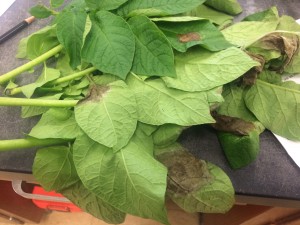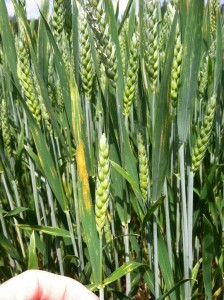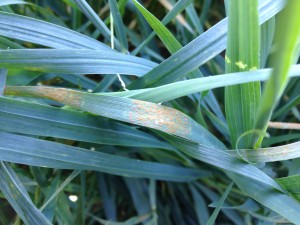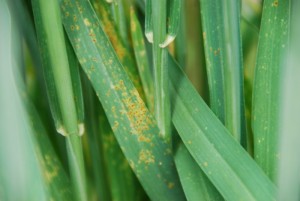Late blight was found in Accomack County, VA yesterday on potato. Growers on the Eastern Shore and other areas of the Commonwealth should scout their fields and take preventative measures. Please let us know if you have any questions. For more information on this potentially devastating disease of potato and tomato visit: https://pubs.ext.vt.edu/ANR/ANR-6/ANR-6_pdf.pdf
Tag Archives: Urgent News
Wheat Disease Update – May 3, 2016
Due to the recent rain, scab risk is increasing in portions of Virginia, especially on the Eastern Shore and coastal areas. The scab risk assessment tool can be found at http://www.wheatscab.psu.edu. Many fields are at or near flowering. In most areas, moderately resistant (MR) varieties are in the low to medium scab risk category, but keep in mind that many acres are still planted to moderately susceptible (MS) or susceptible (S) varieties such as Shirley. In the eastern portions of the state, scab risk is projected to be high for susceptible varieties over the next week, and it will likely be necessary to work in fungicide applications between rain events. Fungicides targeting scab should be applied within 5-6 days of flowering (50% of main tillers starting to flower from the center of the head). Do NOT apply a strobilurin or fungicide pre-mix containing a strobilurin after flag leaf emergence (Feekes 9) since this can increase DON contamination in the grain. Prosaro, Caramba, and Proline are the most effective products for reducing scab and DON contamination. These fungicides will also control foliar diseases such as leaf blotch, stripe and leaf rust, and powdery mildew. Stripe rust has been observed on susceptible wheat cultivars in some fields for several weeks now, but levels remained low due to dry conditions. The recent rain and humid conditions have resulted in spread of the disease in some areas. Similar conditions are forecasted over the next week and the disease has the potential to spread rapidly, so growers should scout their fields immediately to determine if stripe rust is present.
Wheat Disease Update – April 12, 2016
Stripe rust has been found on wheat in southeastern Virginia (Suffolk) and the Eastern Shore (Northampton County). Stripe rust is not observed every year, but it can be more aggressive than leaf rust and spread very quickly if temperatures are moderately warm and humidity/rainfall is high. Many wheat varieties are susceptible, and we do not have good stripe rust ratings for the region because the disease is fairly rare. Pictures showing typical symptoms of leaf rust and stripe rust are below. Fields should be scouted, and keep in mind it is more important to catch stripe rust early than leaf rust. If a field has good yield potential and stripe rust is present, a fungicide application is recommended. In addition to rust, powdery mildew has been reported from throughout Virginia and leaf blotch has been observed in southeastern Virginia, so as the wheat crop approaches the flag leaf emergence growth stage, it is time to start thinking about disease management. For specific fungicide recommendations, see my earlier post (April 7, 2016).
26th Annual Eastern Shore of Virginia Ag Conference & Trade Show
The Eastern Shore of Virginia Ag Conference & Trade Show is on! We are snow free, and looking forward to a great event on January 26 and 27, 2016. The event will take place at the Eastern Shore Community College Workforce Development Center in Melfa, VA. The full program can be found at: http://issuu.com/esarec/docs/flipbookfinal/1. We have been approved for Certified Crop Adviser (CCA) CEU credits (details at: https://www.dropbox.com/s/f34f3spg4quni7a/CCA_Credits_Handout_2016.pdf?dl=0), Virginia Nutrient Management Credit (1 credit), and Virginia Pesticide Recertification credits (information in the program). See you there! Directions can be found at: http://es.vccs.edu/about/mapdirections/.
Stop peanut digging until frost potential passes
Due to the frost and freeze advisories in effect from Sunday through Tuesday night (Oct 19 through Oct 21) in the V-C region, I recommend that peanut digging be stopped after today (Thu, Oct 15). Peanuts will need three days to dry in order to not be affected by frost. Resume digging only after temperatures become milder.
Frost advisory is available at http://webipm.ento.vt.edu/cgi-bin/listfrost
Virginia Frost Advisory
The Virginia Frost Advisory predicts that a frost is expected next Monday morning (10/19) for Suffolk, Capron, Waverly, Skippers, and Lewiston. A copy of the report can be downloaded below. For up-to-date frost advisories for the region, see the Peanut-Cotton Infonet (http://webipm.ento.vt.edu/cgi-bin/listfrost).
Sugarcane aphids found in Isle of Wight sorghum field (Sep. 18, 2015)
Another Virginia county has been found with sugarcane aphid in sorghum. Please see the attachment for more details. SCA_advisory_Sep_18_2015
Corn disease update — July 28, 2015
In an update to my previous post, southern corn rust has now been confirmed in Chesapeake, VA. This is a few days earlier than in 2014 (August 3), but most of the field corn in the region is mature enough (dent stage) that yield should not be impacted. Late planted corn in fields with good yield potential (120 bu/ac +) may need to be protected with a foliar fungicide. Strobilurins are good preventative fungicides whereas triazoles are recommended once sporulation is observed in a field due to their curative activity. A combination fungicide is a good option as long as a strobilurin fungicide has not been applied previously. Wet, warm weather favors disease development. Once sporulation occurs, symptoms of rust are relatively obvious. Lesions start out as raised, blister-like pustules then break open to reveal orange spores. Samples of corn plants with symptoms of southern rust can be submitted to the disease clinic at the Virginia Tech Tidewater AREC (contact Dr. Hillary Mehl, hlmehl@vt.edu).
Black flag seen in some Virginia cotton fields
As you may have heard, reports out of northeastern North Carolina are talking about infestations of plant bugs (Lygus) causing a symptom called “black flag” by feeding on presquare cotton. This is very rare in US cotton. This symptom is termed “black flag” due to the death and blackened appearance of the expanding terminal leaves. The danger is creating “crazy cotton”, which is loss of apical dominance, causing multiple terminals per plant, delayed squaring, or yield loss. Terminals can be destroyed from only 20 minutes of feeding.
But it is important to remember that given good conditions, cotton can recover later in the season without yield loss. We did research earlier in Virginia that showed that even this far north, cotton can easily compensate from removal of squares—even up to 20 percent—so this black flag injury may not be as big a threat as you may be thinking it is.
The plant bugs that are causing this problem are from a generation that developed on weeds and is moving through the system. It is important to keep in mind that plant bug infestations are very erratic. Some fields may be infested, or even some areas within a field—but not every field. We and others have checked a lot of cotton fields in Virginia and are finding just a few with very limited amounts of black flag.
We don’t want to overreact to this and spray all of our cotton just because we have seen this problem in a few plants in one area. If you do see these symptoms you should use a sweep net to see if plant bugs are still present (see recommendations below). Overreacting could certainly help flair other problems as well as waste money if plant bugs are not present at damaging levels.
Management on presquare cotton (borrowed from NCSU)
1. Use a sweep net to make 25 sweep samples and count the adults. Realize that bug numbers will be higher in field edges, so move around. A sample of 25 sweeps per location (one set of 25 “swooshes”) should be adequate.
2. Where you sweep, look for black flag, wilted leaves, or injured terminals. If you see this injury, and have plant bugs present, spray if the number of injured terminals is greater than 1 plant in 10 feet of row (borrowed from Mississippi State). If you do decide to spray, use a neonicotinoid at the highest labeled rate at this point in the season. They tend to be less effective as the season goes on, but should do the trick, while preserving some beneficials. Examples include Admire Pro, Belay and Centric. DO NOT use an organophosphate or pyrethroid this early in the season. These will kill the beneficials and could help flare spider mites and/or aphids. We are seeing some of both in a few fields so the risk of flaring these pests is pretty high—and would be very costly.
3. Monitor the situation after the spray. A visit and sweeping 24 hours following the spray should give you a good idea of knockdown. Since you’ve swept and know the plant bug numbers prespray, another good visit would be 4-5 days later. See if plant bugs have migrated in again and if the terminal injury is holding steady or increasing.
4. Once the plants start squaring, you need to use a threshold that incorporates plant bug numbers with square retention measurements. You can find scouting recommendations and the threshold for squaring cotton in the Virginia Cotton Production Guide, http://www.pubs.ext.vt.edu/AREC/AREC-124/AREC-124.html.
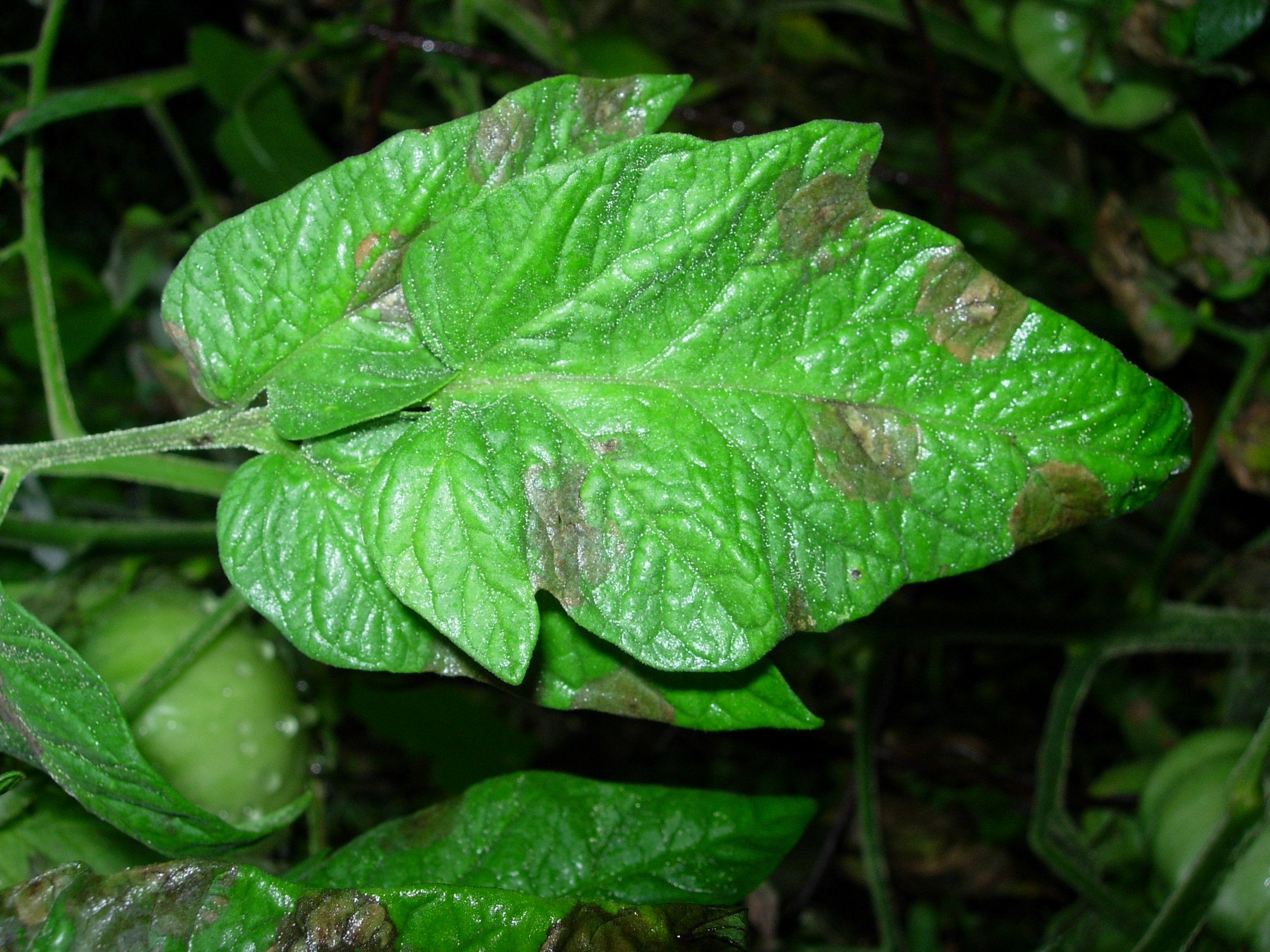
Late blight found on Tomato in Rappahannock County, Virginia
The following information is from Elizabeth Bush with the Virginia Tech Plant Disease Clinic: Late blight has been confirmed on tomato in Washington, VA by the Virginia Tech Plant Disease Clinic. Potato and tomato growers (especially in the northern part of the Commonwealth) should take precautionary actions and increase scouting. Cool and wet conditions favor development of this disease and fungicide sprays should be in place before the disease is present in a field or garden. For more information on late blight and late blight management refer to the Extension publication available at http://pubs.ext.vt.edu/ANR/ANR-6/ANR-6_pdf.pdf . Late blight was previously identified in Loudoun County, VA on July 22.

